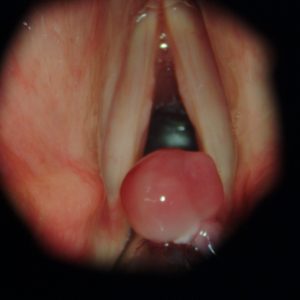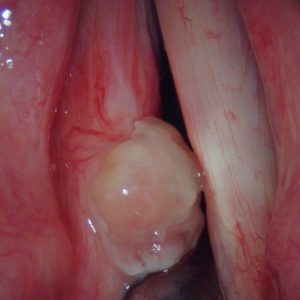Contact granuloma is a growth of inflammatory tissue that forms on the vocal process of the arytenoid cartilage—where the vocal folds come together—typically due to repeated irritation. This irritation can come from forceful voice use, chronic throat clearing, or acid reflux. Patients often feel a tickle or lump in the throat, persistent hoarseness, and pain when speaking, usually on one side. Over time, the lesion can grow and become large enough to affect vocal quality or breathing. It often develops gradually in people who speak loudly, forcefully, or for long periods, especially men.
Treatment usually begins in the office. Voice therapy is recommended to reduce strain, and patients are started on aggressive acid reflux control. Inhaled or injected steroids may be used to reduce inflammation. In some cases, Botox injections into the vocal muscles are offered to temporarily relax the area and allow healing. If the granuloma is large, painful, or obstructing the airway, it may be removed surgically under general anesthesia. The granuloma can also be precisely treated with a blue laser or KTP laser, either in-office or in the operating room. Recovery involves voice rest, reflux management, and regular monitoring to prevent recurrence.

Contact Granuloma

Contact Granuloma
Intubation granuloma is a type of vocal lesion that forms after a patient has been intubated—when a breathing tube is inserted during surgery or hospitalization. The pressure or movement of the tube can irritate the tissue at the back of the voice box, especially if the tube was in place for a long time. These granulomas usually appear a few days or weeks after the hospital stay. Patients may notice new hoarseness, breathiness, or even a weak or absent voice.
These lesions can be quite large, but often respond well to conservative treatment. In our office, we typically begin with high-dose acid reflux medications, inhaled or oral steroids, and careful monitoring. If the granuloma does not improve or if it affects breathing, we may recommend blue laser or KTP laser ablation, which can often be done in the office. In rare cases, if the lesion causes airway obstruction, surgical removal under general anesthesia may be necessary. Most patients recover fully with non-surgical care and ongoing voice and reflux management.
A contact ulcer is a painful sore that develops on the vocal process—the point where the vocal cords meet—usually from chronic irritation. It is often an early stage in the same process that leads to a contact granuloma. The ulcer may be caused by voice overuse, excessive throat clearing, or acid reflux, and typically occurs on one side of the throat. Patients with a contact ulcer often report a sharp pain during speaking or swallowing, and may feel like something is stuck in their throat. Hoarseness and a dry, irritated throat are also common. These ulcers develop slowly and can become more painful over time if not addressed. Treatment does not usually involve surgery. Instead, we focus on stopping the irritation: this includes voice therapy to change speaking patterns, non-acid and acid reflux treatment, and sometimes an inhaled or injected steroid to reduce inflammation. If treated early, contact ulcers usually heal without the need for further intervention.
Osteosclerosis of the arytenoid cartilage is a hardening or thickening of the cartilage at the back of the voice box. This condition may not be visible on a basic exam, but can be seen on a CT scan. It is most often discovered in patients who have recurrent contact granulomas that don’t improve with treatment. The hardened cartilage can press against the opposite vocal cord and prevent the area from healing properly. Patients with osteosclerosis may feel hoarseness, vocal fatigue, or discomfort on one side of the throat. Because it causes mechanical irritation, even a small area of thickening can lead to repeat trauma with every vocal fold closure. Treatment begins with reflux control and may include steroid injections or antibiotics if there is inflammation. In rare, persistent cases, surgery may be needed to reshape or reduce the thickened cartilage. Recovery depends on the severity of the disease and may include continued voice therapy and close follow-up.

 YouTube Channel
YouTube Channel
